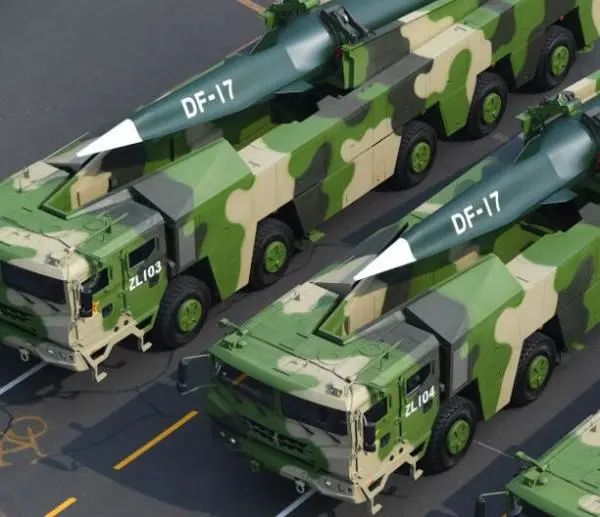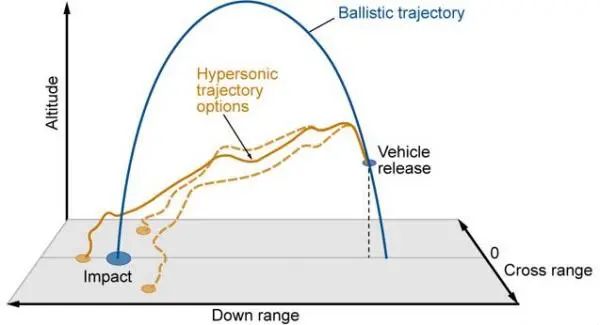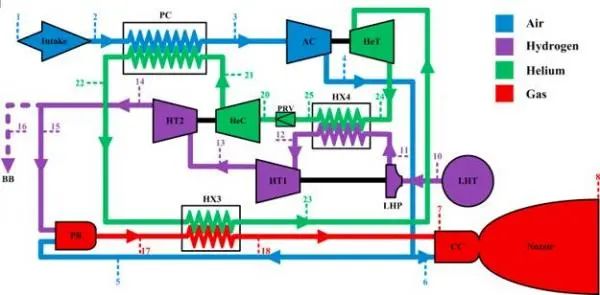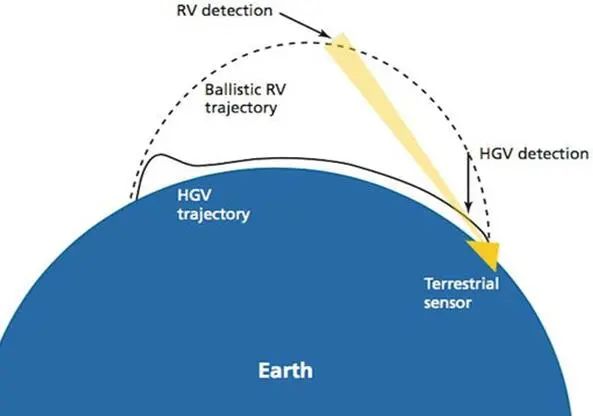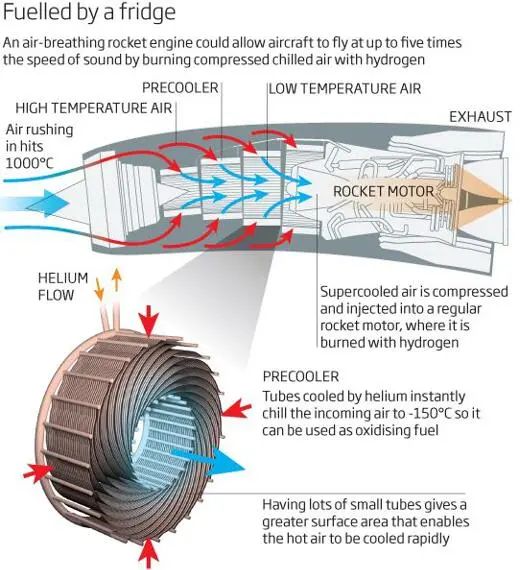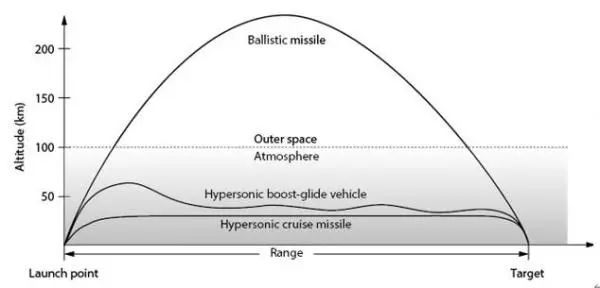(Machine translated) The Institute of Mechanics of the Chinese Academy of Sciences 中国科学院力学研究所 quietly released a message that 范学军 Fan Xuejun’s team achieved a continuous 600-second run time in a ground test of a super-combustion ram engine, breaking the world record of 210 seconds for an American X-51 research aircraft. in 2016, India announced that it had achieved a super-combustion ram-powered M6 high supersonic flight, but the engine worked for only five seconds. Not long ago, the Ministry of Science and Technology announced the second national innovation first prize list, 北航 high supersonic speed strong pre-cooling team won the award, also attracted great attention. The significance of these two breakthrough technologies is immense. Hypersonic speed is at the forefront of aerospace technology. This is also the gray area between aviation in the lower atmosphere and the outer space. In between, the high supersonic speed of flight not only allows the M5-20 to fly at very high speed, but also has considerable maneuverability.
On 70th anniversary of the National Day in 2019, China made a display of the 东风 Dongfeng 17 hypersonic missile, which represents the highest level of hypersonic speed currently available, but this is still the hypersonic glider (HGV for short). In other words, after the missile is propelled to near ground altitude with a rocket engine, it changes attitude and transitions into a hypersonic glide.
Compared to ballistic missiles, HGVs have a low flight altitude, and because of the curvature of the Earth, the ground radar’s detection range is much lower than that of ballistic missiles, and the cruise altitude of the early warning aircraft does not fundamentally solve the problem. Space-based detection in orbit is theoretically not limited by field of view, but conventional missile warning is based on the huge tail flames and initial trajectory of the missile at launch to infer trajectory, HGV still has the tail flames problem at launch, but after switching to glide, it can completely get rid of simple trajectory by its maneuvering capability, making the trajectory of the missile unpredictable. While it is theoretically possible to track with an on-board radar the entire time immediately after detection of launch, tracking of medium-orbit satellites requires a large on-board radar, while low-orbit satellites require a dense constellation and “dynamic-to-active” gapless relay tracking. Infrared photonics tracking not only has similar optical aperture problems, but also faces the problem of detecting faint HGV thermal features in the complex thermal environment of the Earth’s surface. In the foreseeable future, space-based detection will also have insurmountable technical difficulties. Without effective tracking, you can’t talk about effective interception, so the HGV has a higher assault capability than a faster but dull ballistic missile. It is for this reason that HGVs have become the focus of military research in various countries. China has not only the Dongfeng 17, but also the Dongfeng 26, which also has the ability to glide at high supersonic speeds. The Russian “pioneer” is the Intercontinental HGV, which reaches the extreme high speed of the M27. The U.S. is behind, and after a dizzying array of fast-track R&D plans, it’s finally starting to get a bit of a head start. However, the range of the HGV depends on the altitude reached by the booster section or the leveling acceleration in the atmosphere, the former increasing the difficulty of the smooth transition from the abrupt back to horizontal sliding, the latter forcefully twisting the booster section of the ballistics and spending fuel.
Higher up the hierarchy than the HGV is the high supersonic cruise missile. Cruise missiles are an ambiguity-prone designation, which is really an umbrella term for all missiles that are powered at the vast majority of their range, and high-subsonic cruise missiles that sweep the ground are just one type of cruise missile. Most tactical missiles are not called cruise missiles because the rocket engine only works for a short time and the main part of the range is gliding flight. This is true not only for ballistic missiles, but also for air-air, air-ground and even anti-tank missiles. The only common missiles are anti-ship missiles and land-attack cruise missiles that are fully powered. The hypersonic missile is called a hypersonic cruise missile (HCM) because it is powered by a super-combustion ram engine.
Compared to the HGV, the HCM has a larger range and more difficult ballistics to detect, and all of the HGV’s energy comes from the booster stage rocket engine. A rocket engine with its own oxidizer always is heavier than a jet engine that can suck oxygen out of the air. In the case of a kerosene-liquid oxygen rocket, the ideal combustion air-to-air ratio is 15:1, i.e., each kilogram of aviation kerosene requires 15 kilograms of oxygen to burn completely. You can save volume with liquid oxygen, but the weight is still the same. If oxygen could come from air, in theory, all of that 15 kg of liquid oxygen weight could be diverted to kerosene, with an increase in range .
The longer operating time of the jet engine also means that there can be longer acceleration times, the same top speed can be reached with less initial energy, and the same top speed can be maintained for longer. More power from a jet engine also means allowing for more maneuverability, since maneuvering is about expending energy. Unlike HGVs that can only do relatively simple lateral maneuvers, HCMs can do more complex maneuvers and even evasive attacks.
HCM’s boosters are simply accelerated to ignition speed for super-combustion ramming, so the booster requirements are greatly reduced, helping to reduce the size and weight of the booster. A smaller booster means a smaller thermal signature at launch, and the super-combustion ram itself has a much smaller thermal signature than the rocket engine, meaning that the HCM is virtually impossible to capture by space-based probes, further enhancing its ability to resist early warning. High supersonic missiles are already difficult to intercept, and interception without warning is almost impossible. The HCM is the ultimate hypersonic weapon. The U.S. had wanted to develop HCM directly in one step, but was stuck on the power issue; although the X-51 reached 210 seconds, it was a highly optimized test condition, and its operating time was too short to be practical. When the United States slowly progresses, China quietly caught up, and at once made a breakthrough in two key technologies.
Of the various known aerodynamic forces, rocket engines have too short an operating time for conventional turbojet engines to break above M2.5, and conventional sub-combustion ramming is difficult to break above M4, as the increase in drag is already faster than the increase in thrust. Only super-combustion ramming can be used for HCM, which is both a ramming engine and a jet engine, unlike the turbo-mechanics of a conventional turbojet engine. A super-combustible punch is a hollow tube in appearance, but there’s a lot more to this hollow tube. In contrast to sub-combustion ramming, the inlet compression, combustion and formation of thrusts in super-combustion ramming are carried out at supersonic speeds. Compared to sub-combustion ramming which requires lowering the intake to subsonic speeds and then accelerating the gas to supersonic speeds, the drag is greatly reduced. However, under supersonic conditions, not only is the combustion difficult to stabilize, but there is also the problem of high temperatures, which can easily exceed the temperature resistance limit of the structural material. The main contribution of the FAN team is the active cooling technology of the hot end components.
Engines powered by combustion usually have some sort of cooling. Automotive engines are essentially liquid-cooled, with the circulating coolant taking heat away from the engine and sending it through the radiator into the air; jet engines rely primarily on air flow and gas ejection to take heat away. But active cooling spreads under the surface of the hot end engine components (in the case of super-combustion ramming, that’s the combustion chamber and nozzles) in capillaries that pass into the hydrocarbon fuel, taking heat away in the flow and lowering the surface temperature. The actual temperature of the hydrocarbon fuel after heat absorption rises above the ignition temperature, but only rises due to the anaerobic environment and does not burn. However, when hydrocarbon fuel is injected into the combustion chamber, it is naturally depressurized on the one hand, and mixed with oxygen in the incoming gas and burned naturally on the other, which is more efficient and reliable than the usual ignition.
Hydrocarbon fuel is an advanced form of fuel oil, which can be easily converted to liquid hydrogen for greater heat absorption and combustion efficiency. However, liquid hydrogen is more complex to prepare and store than hydrocarbon fuels, and is less stable at room temperature and pressure. Fan Xuejun’s team uses hydrocarbon fuel, which is less expensive and more stable.
The rationale for active cooling isn’t complicated and the benefits are obvious, but the devil is in the details. The flow of hydrocarbon fuel in capillaries requires consideration of blockage. The distribution of capillaries is of great importance, it is not necessary to be too fine, cooling is not achieved if too large. The bigger problem is that in the flow network, the preferential flow makes the flow distribution deviate from the expected uniformity, and in a bundle of seemingly similar tubes, the flow rate inside the tubes may not be even. Midway interconnection between paths can be made up with bypass flow when part of the path is blocked, but further complicates the problem of achieving optimate flow. The problem of gas resistance after the fluid is heated and vaporized has to be avoided also.
Fan Xuejun’s team not only solved a large number of theoretical and design problems, but also built a large test set in 怀柔, solving engineering problems and bringing the research results to a high level of technical maturity.
Fan Xuejun received his PhD in Princeton and became a researcher and PhD director of the Institute of Mechanics, serving as an expert in the professional group of delivery technology of a certain ministry, an expert in the national major special fuel group and the chief technology of a certain major project. He took the lead in conducting research on active cooling engine technology in China and built the first set of active cooling technology comprehensive test platform at the 怀柔 base of the Institute of Mechanics, which is at the international leading level in technology. He led the development of China’s first active cooling combustion chamber and passed a long test. In recent years, the company has published more than 50 papers in domestic and foreign magazines, more than 100 conference papers and national defense technical reports, and applied for more than 30 invention patents and has authorized nearly 20 inventions. But this isn’t the only top team in China’s hypersonic research army; 北航 Beihang’s hypersonic strong precooling team is another.
Active cooling technology improves the heat resistance of the hot end components of the engine, which can be further improved by strong pre-cooling of the intake air. Not long ago, the SABRE engine in the UK achieved strong pre-cooling, cooling an intake of 1000 degrees to minus 150 degrees in 0.01 seconds. That’s quite an achievement. The specific techniques and applications of the 北航s team were not published, but are of the same nature.
Strong pre-cooling not only dramatically increases the high temperature resistance limit of the hot end components of the engine, but also drastically reduces the volume of air intake and increases the air intake density. This results in a significant reduction in the volume flow of the compressor at the same inlet volume flow, or a significant increase in the oxygen content of the air stream at the same compressor volume flow. The former can be equated with an increase in the upper limit of air inlet velocity, making the same engine technology work at higher speeds; the latter is particularly important for very thin air at very high altitudes, allowing jet engines to work steadily at higher altitudes, reducing air frictional resistance, otherwise it would be necessary to use heavy, costly and short working time of the rocket engine. SABRE is exactly that.The full name of SABRE is Synergetic Air Breathing Rocket Engine, which means Accompanying Aspirated Rocket Engine. This is a new concept hybrid engine for the horizontal take-off, single-stage, orbiting space shuttle, which uses strong pre-cooling to maintain the working state of drawing oxygen from the air all the way to M5 and ultra-high altitude, before being transferred to rocket power and into space flight.
Specifically, the incoming air, after being strongly pre-cooled in a pre-cooler (PC), reaches high pressure through an air compressor (AC); part of it enters the combustion chamber (CC), where it is mixed with the pre-fired hot, oxygen-poor, hydrogen-rich gas and burned to generate thrust through a nozzle; most of the air enters the pre-fired chamber (PB), where it is mixed with the hydrogen and burned to heat helium gas. The helium gas is heated to expand and drives a helium turbine (HeT) to drive the gas press. The helium gas, which is still very hot after being cooled down, is heated and vaporized by a heat exchanger (HX4) to form a high pressure, which drives a hydrogen turbine (HT1) to drive a liquid hydrogen pump (LHP) to pump liquid hydrogen from a liquid hydrogen storage tank (LHT). There is still enough hydrogen pressure left to continue to drive another hydrogen turbine (HT2) that drives a helium refrigeration compressor (HeC) for the pre-cooler, just as a Freon compressor in a refrigerator supplies refrigerant. In fact, helium is the equivalent of Freon here.
SABRE’s thermodynamic cycle is complex and sophisticated; SABRE was not originally designed for super-combustion ramming; the use of aspirated rocket engines avoids the problem of super-combustion ramming, and high supersonic speeds within the atmosphere are only a transitional phase, providing the highest possible starting speed and altitude for rocket powered flights outside the atmosphere. But properly simplified, SABRE’s thinking can also be applied to super-combustion ramming. For example, by eliminating the helium loop, the fuel pumped out goes directly to the pre-cooler and hot end cooling system, heating gasification generates high pressure, and the driven turbine drives the fuel pump directly. This way, even the pre-combustion chamber can be eliminated.
Active cooling and strong pre-cooling are both thermal management techniques for super-combustion ram engines. People often focus on the combustion stability of super-combustion ramming, which is indeed a huge technical challenge, as tough as a controlled explosion, but thermal management is an equally huge challenge. China hinted at a fairly high level of technical maturity in super-combustion stamping technology at the landmark Xiamen International Conference in 2017. Thermal management technology has also now reached a high level of technical maturity, and what is not publicly available is only a high supersonic flight test of a complete super-combustion ram engine with advanced thermal management.
The significance of the practicality of super-combustion stamping cannot be overstated. Only the appearance of the Dongfeng 17 was made public at the National Day 70 celebration, the range was not announced, and is estimated to be in the 1800-2500 km range. By using super-combustion ramming and changing from HGV to HCM, only a small booster rocket is needed for take-off, and the weight of the large amount of oxidizer used can be converted to fuel, greatly increasing the range. Even accounting for the heavier super-combustion ram engine and auxiliary systems, the increase in range is conceivable. Even if it is not possible to increase the range by a factor of 15, but only by a factor of 5, it will be possible to achieve a range of 9000-12500 km with roughly the same full system size and weight. If the Dongfeng 17 is still just “Guam Express”, then “Super Dongfeng 17” is not just Guam Express, but “Hawaii Express”, “Los Angeles Express”, the military significance is self-evident.
China’s high-tech research and development of military significance has a tradition of secrecy, and the complete super-combustion ramming test with heat management has been carried out or not, and whether it was successful or not, the outside world can only speculate. But one needn’t be too surprised to find out where another innovation award was quietly declared not too long ago, or where a brand new HCM was swooped in at a major celebration.
On the other side of the Pacific, the U.S. tested the successful C-HGB on March 19, an HGV common to all three armies, but still using the first-generation bicone (also known as a spintron), rather than the more advanced multiplier used by Dongfeng 17. On the other hand, the United States Under Secretary of Defense for Scientific Research Griffin, speaking about hypersonic research, specifically mentioned the lack of access to thermal management in the United States, which has reduced the range of hypersonic missiles, which would have reached 3,000 km, to 1,000 km. If China is still a step away from HCM, the United States is yet to cross the midfield. Hypersonic speed is one of the few military-industrial technologies in which China holds a decisive lead, which happens to be the core military-industrial technology that will be critical to future wars.

